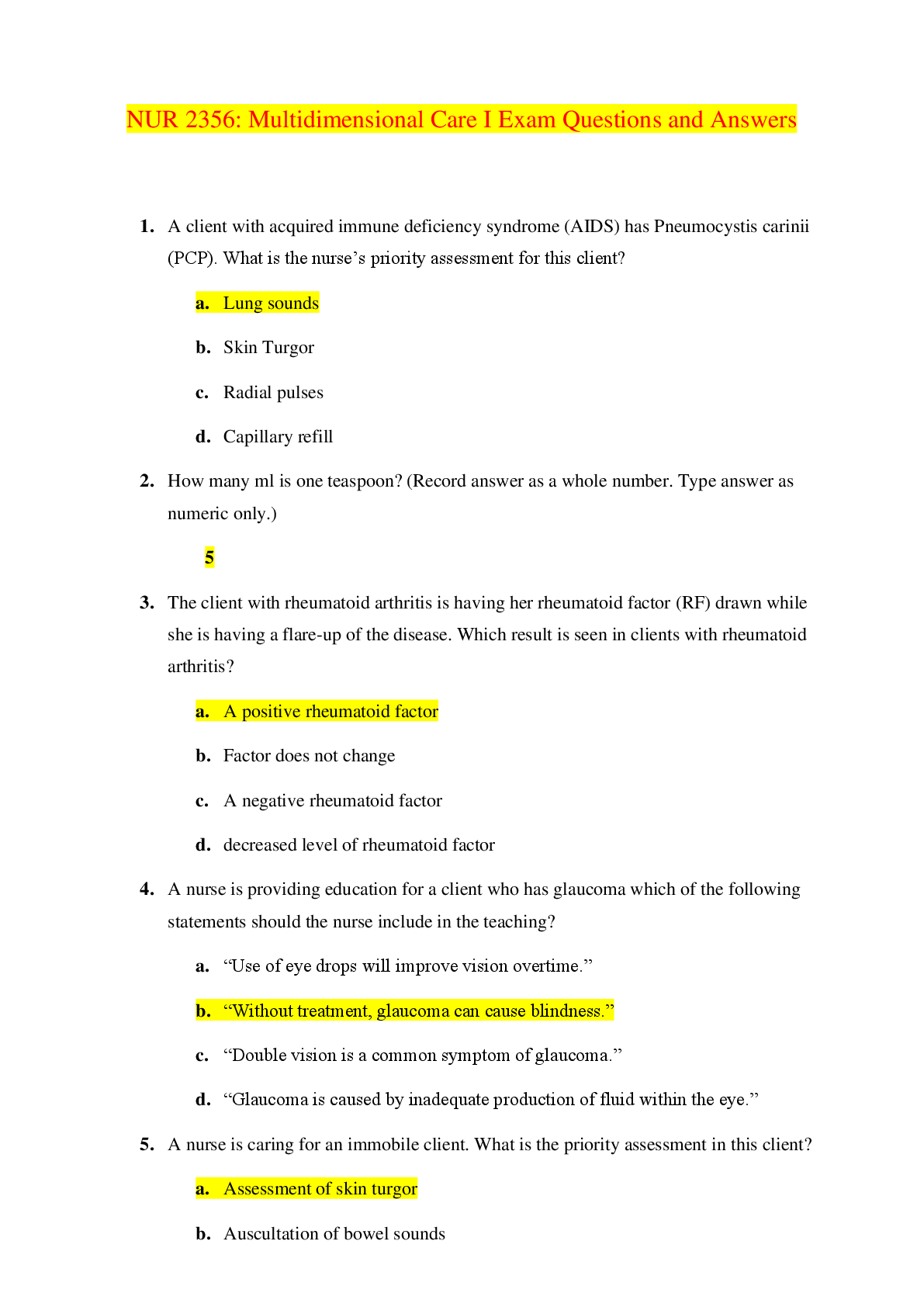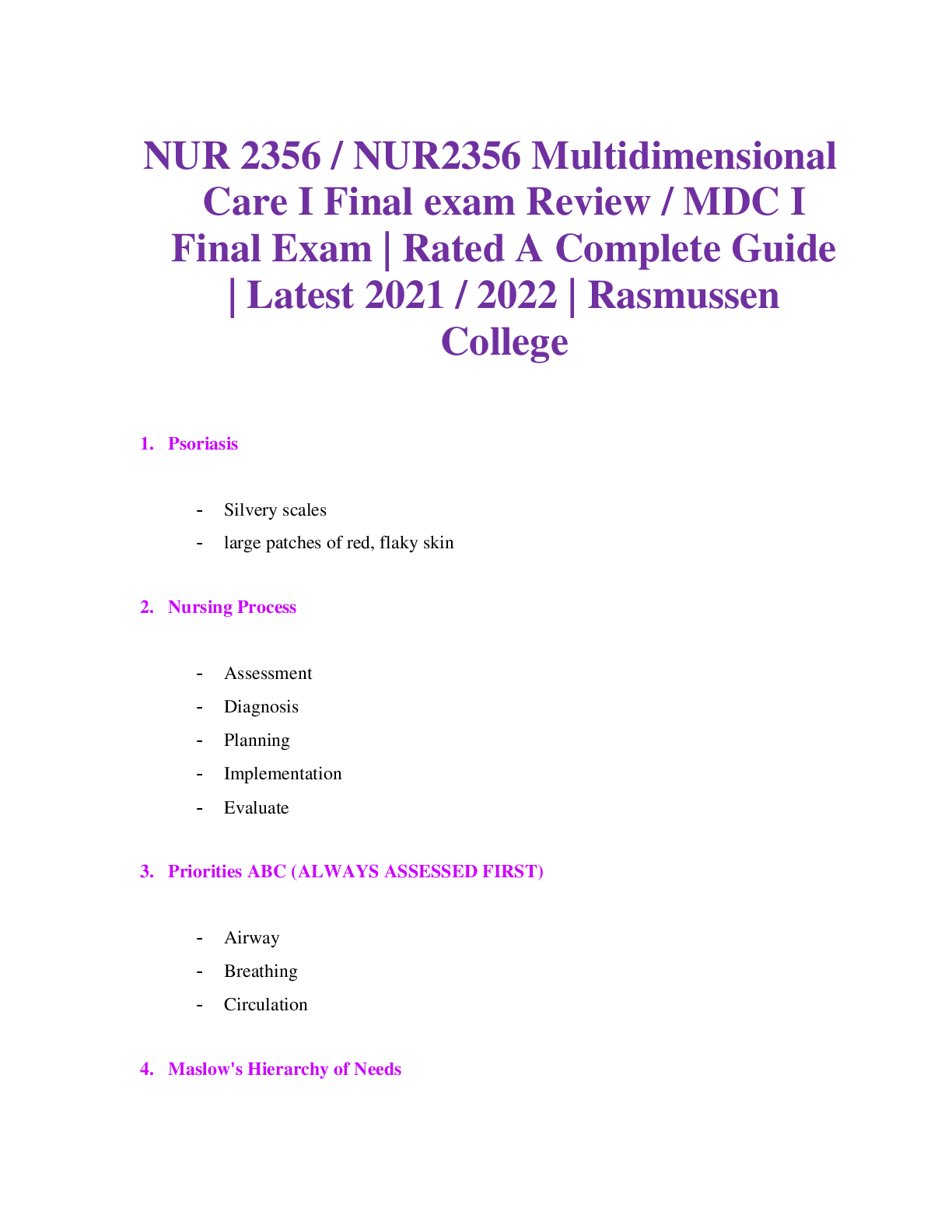Human Resource Management > Final Exam Review > HRMT 413 FINAL EXAM WITH COMPLETE SOLUTION GRADED A EXAM. (All)
HRMT 413 FINAL EXAM WITH COMPLETE SOLUTION GRADED A EXAM.
Document Content and Description Below
HRMT 413 FINAL EXAM WITH COMPLETE SOLUTION GRADED A EXAM. Question 1 of 40 0.5 / 0.5 Points The lesson material cites which hospitality company as an example of successful unionavoida ... nce strategy? • A. Darden Restaurants • B. Hilton Hotels • C. Rosen Hotels & Resorts • D. The Disney Company Answer Key: C Question 2 of 40 0.5 / 0.5 Points Union environments where union dues paying is mandatory are called: • A. agency shop • B. none of these choices • C. union shop • D. restricted shop • E. paid shop Answer Key: A Question 3 of 40 0.5 / 0.5 Points The union avoidance strategy which seeks to deter union efforts by mimicing union environments internally is: • A. distributive approach • B. none of these choices • C. integrative approach • D. philosophy-laden approach • E. indoctrination approach Answer Key: B Question 4 of 40 0.5 / 0.5 Points The union avoidance strategy which seeks to deter union efforts by resolving employeecomplaints and leaving unions without any value proposition is: • A. indoctrination approach • B. philosophy-laden approach • C. none of these choices • D. distributive approach • E. integrative approach Answer Key: B Question 5 of 40 0.5 / 0.5 Points Negotiating topics in a union agreement are generally broken up into which main categories? A. wages and benefits B. ancillary issues C. shop steward nominations D. anti-discrimination policies E. election protocols Answer Key: A, BQuestion 6 of 40 0.5 / 0.5 Points Plans to increase employee pay over time to account for increases in costs of living are oftenreferred to as: • A. NLRBs • B. COLAs • C. pro rata profit sharing • D. none of these choices • E. FLSAs Answer Key: B Question 7 of 40 0.5 / 0.5 Points Unionization generally leads to which of the following? A. greater productivity B. lesser profitability C. higher pay D. more employment litigation E. reduced shareholder value Answer Key: A, B, C, EQuestion 8 of 40 0.5 / 0.5 Points Which of the following is NOT commonly one of the ancillary issue topics discussed in contractnegotiations? • A. all of these are ancillary issues commonly discussed • B. union security • C. working hours • D. management rights • E. none of these are ancillary issues commonly discussed Answer Key: A Question 9 of 40 0.5 / 0.5 Points When membership in a union is required notwithstanding dues payment, this is called: • A. yellow dog shop • B. agency shop • C. none of these choices • D. closed shop E. union shop Answer Key: E Question 10 of 40 0.5 / 0.5 Points Which of the following is a true statement regarding promotions and transfers in unionenvironments? • A. They happen more frequently but tend to benefit all employees equally • B. They happen less frequently but tend to benefit all employees equally • C. They happen less frequently but tend to benefit more senior employees • D. None of these statements is true • E. They happen more frequently but tend to benefit more senior employees Answer Key: E Question 11 of 40 0.5 / 0.5 Point Bargaining issues which are unenforceable for illegality or unconscionability are called: • A. mandatory issues • B. predetermined issues • C. none of these choices • D. deplorable issues • E. permissive issues Answer Key: C Question 12 of 40 0.5 / 0.5 Points When the employer tries to negotiate with the employees without involving the union, this is called: • A. direct dealing • B. none of these choices • C. employer dodging • D. union circumvention • E. ex parte communication Answer Key: A Question 13 of 40 0.5 / 0.5 Points The lesson material uses what hypothetical context to exemplify the concepts of distributive andintegrative negotiation? • A. buying a car • B. drafting a prenuptial agreement • C. negotiating an employment contract • D. renting an apartment • E. none of these choices Answer Key: A Question 14 of 40 0.5 / 0.5 Points The type of negotiation strategy which views the goals of each party in direct opposition to oneanother is called: • A. none of these choices • B. mutual-gains negotiation • C. adversarial negotiaiton • D. distributive negotiation • E. integrative negotiation Answer Key: D Question 15 of 40 0.5 / 0.5 Points Bargaining issues which the law requires be negotiated in a collective bargaining agreement are called: • A. mandatory issues • B. prohibited issues • C. prerogative issues • D. permissive issues • E. none of these choices Answer Key: A Question 16 of 40 0.5 / 0.5 Points When one party to a bargaining agreement makes an alteration to the agreement terms withoutconsulting or obtaining permission from the other party, this is called: • A. unilateral change • B. multilateral violation • C. bilateral alignment • D. none of these choices • E. solitary redaction Answer Key: A Question 17 of 40 0.5 / 0.5 Points When parties to a bargaining agreement feign sincere good faith and cooperationduringnegotiation, this is called: • A. dubious negotiating • B. surface bargaining • C. direct dealing • D. none of these choices • E. deceitful bargaining Answer Key: B Question 18 of 40 0.0 / 0.5 Points The type of negotiation strategy which perceives alignment between the parties' interests wherepossible, and looks for opportunities to create 'win-win' solutions, is called: • A. altruistic negotiation • B. distributive negotiation • C. integrative negotiation • D. ancillary negotiation • E. none of these choices Answer Key: C Question 19 of 40 0.0 / 0.5 Points Because collective bargaining agreements comprise a large number of issues with differing values to each party, which negotiation strategy is best suited? • A. adversarial negotiation • B. none of these choices • C. integrative negotiation • D. altruistic negotiation • E. distributive negotiation Answer Key: C Question 20 of 40 0.5 / 0.5 Points Bargaining issues which may be negotiated and included in an agreement at the option of the parties are called: • A. none of these choices • B. ancillary issues • C. permissive issues • D. mandatory issues • E. prohibited issues Answer Key: C Question 21 of 40 0.5 / 0.5 Points The type of flexible schedules which allow employees to work their required quantities of hoursat times that they choose is called: • A. none of these choices • B. flex-time • C. ROWE • D. timesharing • E. schedule empowerment Answer Key: B Question 22 of 40 0.5 / 0.5 Points Which gainsharing strategy looks at value added considering total production value of an entirework team? • A. None of these choices • B. Impro-Share • C. Profit Sharing • D. Scanlon Plan • E. Rucker Plan Answer Key: E Question 23 of 40 0.5 / 0.5 Points When employee compensation scales are based upon company efficiency, productivity, or other performance metrics, this is called: • A. none of these choices • B. stock purchase allocation • C. COLAs • D. pay for play • E. standard increase paradigms Answer Key: A Question 24 of 40 0.0 / 0.5 Points Which type of innovative work environment consists of no schedules or required hours whatsoever, instead focusing on employee productivity through meeting work completion deadlines and other goals? • A. freework • B. ROWE • C. none of these choices • D. telecommuting • E. flex-time Answer Key: B Question 25 of 40 0.5 / 0.5 Points Employee involvement and quality of life programs involve which of the following? • A. generating commitment • B. implementing change • C. improving climate • D. all of these are correct • E. none of these are correct Answer Key: D Question 26 of 40 0.5 / 0.5 Points For which types of industries would innovative schedule strategies like flex-time and ROWE notbe feasible or practical? A. architects B. software developers C. hotels and restaurants D. police and emergency services E. hospitals Answer Key: C, D, EQuestion 27 of 40 0.5 / 0.5 Points Workplace intervention strategies where employees and managers collaborate to discuss andresolve workplace concerns and complaints is called: • A. labor-management committees • B. work councils • C. none of these choices • D. union shops • E. workplace synergy teams Answer Key: A Question 28 of 40 0.5 / 0.5 Points A gainsharing plan which typically involves very little management change and which rewards employees for meeting performance targets weekly is called: • A. Scanlon Plan • B. Rucker Plan • C. none of these choices • D. Marshall Plan • E. ROWE Answer Key: C Question 29 of 40 0.5 / 0.5 Points A gainsharing plan which uses the simple metric of production per hour by dividing payroll costs into sales revenue is called: • A. Scanlon Plan • B. Marshall Plan • C. Rucker Plan • D. Impro-Share • E. none of these choices Answer Key: A Question 30 of 40 0.5 / 0.5 Points Which of the following circumstances are necessary for self-managed work teams to succeed? A. exclusive use of integrative negotiation strategies B. adoption of either the Scanlon Plan or Rucker Plan C. willingness on the part of management to make substantial changes in policy andprocedure D. work teams that have reach acceptable levels of maturity E. well-compensated employees with acute skills Answer Key: C, D Question 31 of 40 0.5 / 0.5 Points Records of arbitration-style human conflict resolution date back to approximately what year? • A. 0 A.C.E. • B. 1770 A.C.E. • C. 1650 A.C.E. • D. 1890 A.C.E. • E. 1500 B.C.E. Answer Key: A Question 32 of 40 0.5 / 0.5 Points The biggest distinction between work councils in Europe and unions in the Unites States is: • A. none of these choices • B. unions represent more employees in many more industries than work councils • C. work councils are typically more successful at negotiating working conditionsbecause employer cooperation is legally required • D. work councils usually have representation on company executive leadership teams • E. work councils are not beholden to the concerns of employees because they are state-funded Answer Key: D Question 33 of 40 0.5 / 0.5 Points Unions in many parts of Asia are: • A. none of these choices • B. stronger than in the U.S. due to a much larger working class population • C. less regulated than in the United States, allowing for more creative negotiationswith employers • D. limited to industries that are not substantial contributors to GDP • E. prohibited by law or controlled by government Answer Key: E Question 34 of 40 0.5 / 0.5 Points The type of arbitration where the arbitrator must choose between the unmodified settlementproposals of the parties is called: • A. no-negotiation arbitration • B. winner-takes-all arbitration • C. settlement-option arbitration • D. none of these choices • E. take-it-or-leave-it arbitration Answer Key: D Question 35 of 40 0.5 / 0.5 Points Which act codified arbitration as a primary means of resolving disputes between employers andunions? • A. Wagner Act • B. none of these choices • C. Norris-LaGuardia Act • D. Taft-Hartley Act • E. Philip-Morris Act Answer Key: D Question 36 of 40 0.5 / 0.5 Points Which now-abandoned legal rule used to preclude the creation of preemptive arbitration agreements? • A. ex parte negotiation • B. exclusionary rule • C. none of these choices • D. caveat emptor • E. res ipsa loquitur Answer Key: C Question 37 of 40 0.5 / 0.5 Points In public sector union environments, laws commonly prohibit strikes because: • A. shut down of government services could pose a risk to public safety • B. strikes cost employers money and this is considered a violation of tax dollarspending • C. state and federal governments have 11th amendment immunity from labor strikes • D. none of these choices • E. employees have access to arbitration options, and this is a better tool for leverage Answer Key: A Question 38 of 40 0.5 / 0.5 Points With respect to striking internationally, which of the following statements is true? • A. None of these statements are true • B. Generally, strikes are shorter elsewhere in the world, and they occur lessfrequently • C. Generally, strikes are shorter elsewhere in the world, though in some places they occur more frequently • D. Generally, strikes are longer elsewhere in the world, though they occur less frequently • E. Generally, strikes are longer elsewhere in the world, and some places they occurmore frequently Answer Key: C Question 39 of 40 0.5 / 0.5 Points With respect to legal representation in arbitration proceedings: • A. Legal counsel is legally required because each party is obligated to pay legal fees of the victor • B. None of these are correct • C. Legal counsel is legally required because of the complexity of arbitration rules and procedures • D. Legal counsel is not legally required but highly advantageous because attorneys protect their clients from malpractice liability • E. Legal counsel is not legally required but highly advantageous because of the complexity of arbitration rules and proceedingsAnswer Key: E Question 40 of 40 0.5 / 0.5 Points Which of the following are valid reasons why arbitration is an appealing option to largecompanies? A. Arbitration is a private unless both parties waive their rights to privacy B. Arbitration decisions only become effective if both parties consent to the final decision C. An arbitration ruling can be overturned by a judge if the company is dissatisfied withthe outcome D. Arbitration parties benefit significantly from the help of very skilled and expensive attorneys who can navigate the arbitration rules to victory E. Arbitration is legally binding Answer Key: A, D, E [Show More]
Last updated: 3 years ago
Preview 1 out of 26 pages

Buy this document to get the full access instantly
Instant Download Access after purchase
Buy NowInstant download
We Accept:

Reviews( 0 )
$12.00
Can't find what you want? Try our AI powered Search
Document information
Connected school, study & course
About the document
Uploaded On
Apr 30, 2022
Number of pages
26
Written in
All
Additional information
This document has been written for:
Uploaded
Apr 30, 2022
Downloads
0
Views
126


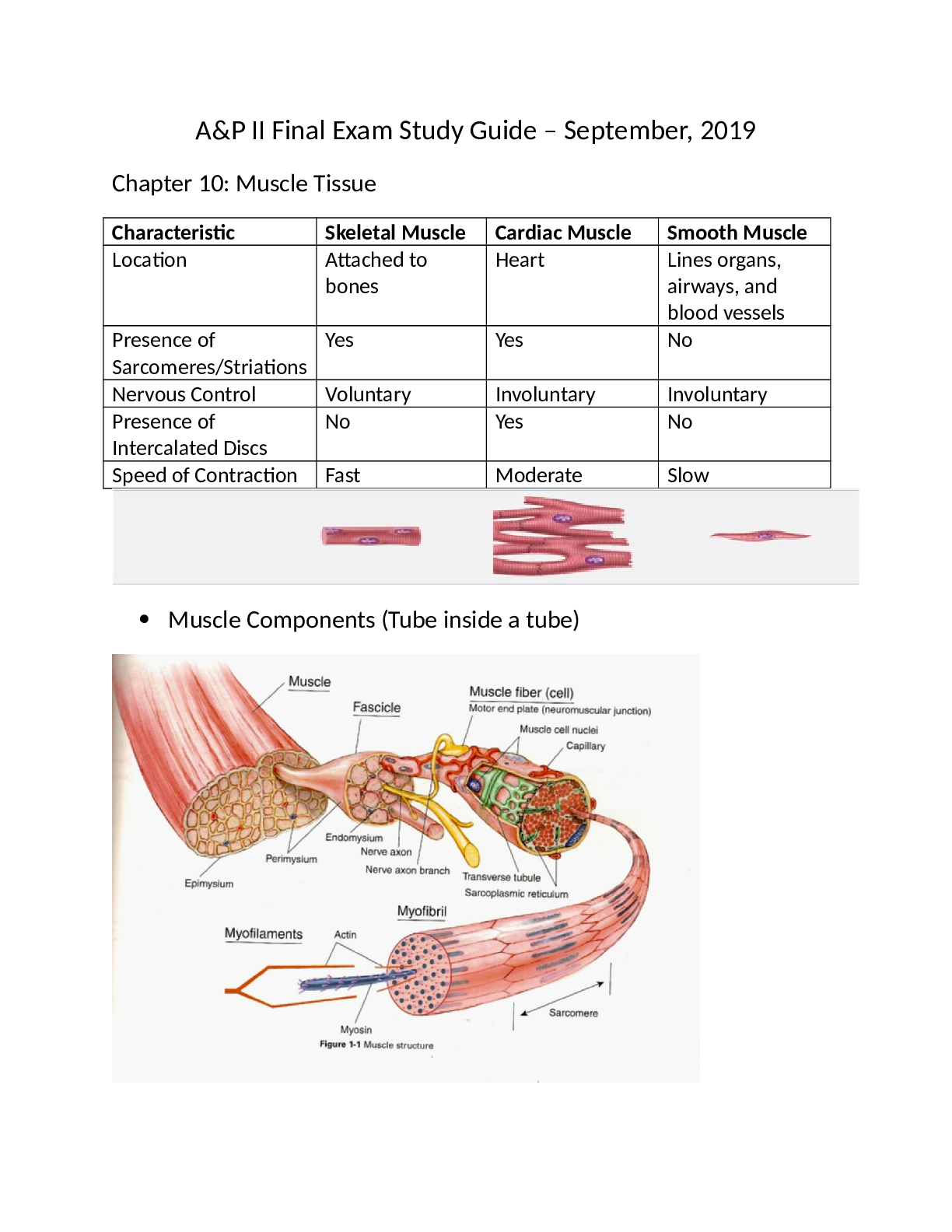








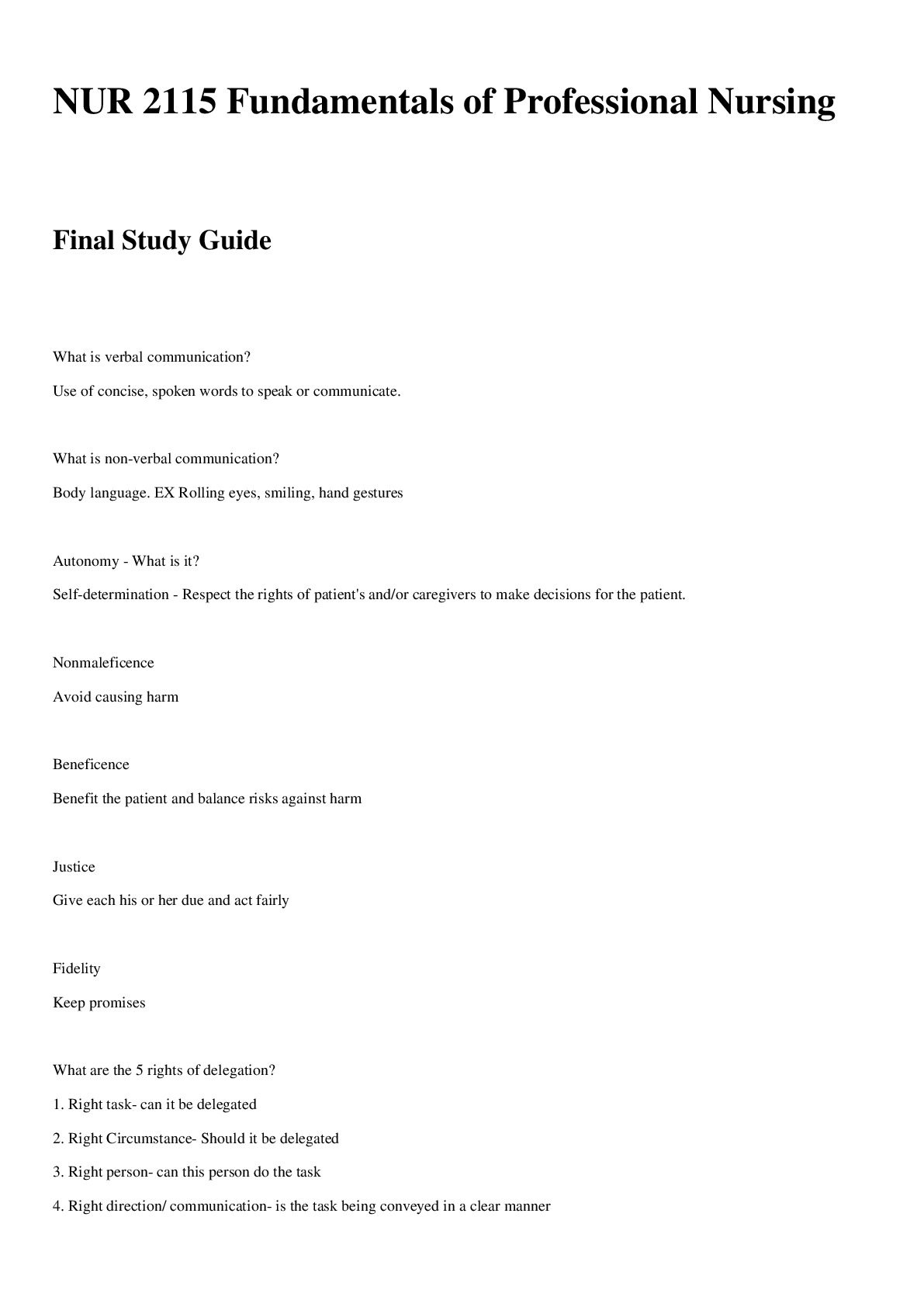
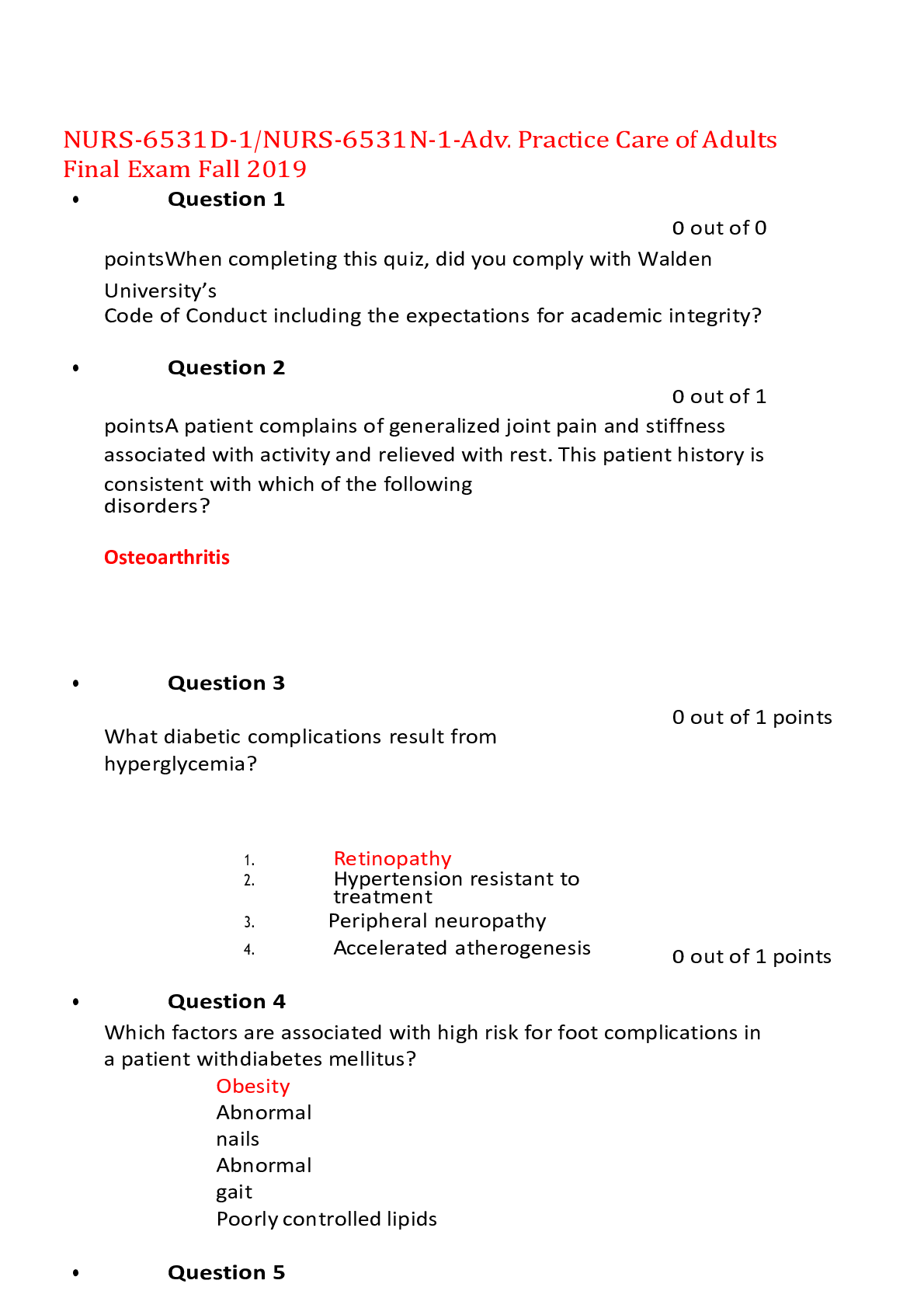
 JN21.png)

